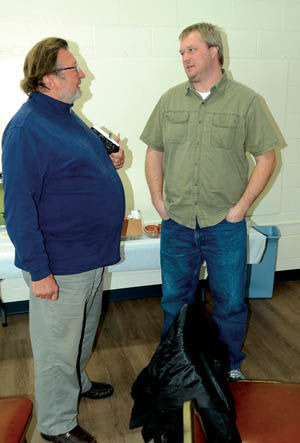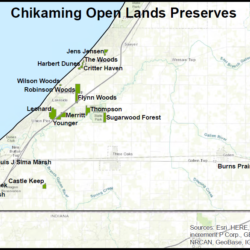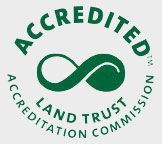
Protecting the land and fighting invasives the focus at New Troy Community Center
Posted on February 7, 2018
Find article HERE.
NEW TROY — Local efforts to protect natural areas from both human disruption and damage inflicted by invasive species took center stage on Saturday, Feb. 3, in the New Troy Community Center.
Chikaming Open Lands Executive Director Ryan Postema and Jared Harmon of the Berrien County Conservation District spoke to 20-plus people during a program on local land conservation issues sponsored by the Conservation District, Chikaming Open Lands and the Friends of New Troy.
Postema gave a brief history of the local land conservancy, noting that Chikaming Open Lands (COL) was founded in 1999, currently has 500 household members, and protects 1,755 acres through 12 Nature Preserves (400 acres) and 31 Conservation Easements.
The non-profit serves nine townships in southern Berrien County. Posterma said most protected land is in Harbor Country area, but added that the largest conservation easement is a 300-plus acre Mize property near Berrien Center.
“We’re a local organization based in Sawyer and we definitely have a community focus,” he said.
Two easements located close to New Troy are 40 acres along Pardee Road owned by Mike Jasper (30-plus agricultural, about 8 wooded) and 8 1/2 acres of Galien River Bottomland owned by Terry and Lorraine Hanover
“You can offer to your grandkids the chance to see the same thing that you grew up with,” Terry Hanover said.
Postema said a municipal easement involves development restrictions on lakefront lands owed by the Village of Michiana. He said COL also worked with Chikaming Township on its Park & Preserve and is informally helping Grand Beach’s in its efforts to acquire a parcel adjacent to COL’s preserve in that community.
Postema said COL’s main mIssions are land protection and stewardship, along with education and outreach (upcoming events include a Feb. 10 day of cross-country skiing, snowshoeing and fat tire snow biking followed by a potluck lunch at Love Creek Nature Center beginning at 10 — RSVPs are sought by Friday, Feb. 9, at jthompson@chikamingopenlands.org or (269) 405-1006).
Postema said an Andrews University student is involved in research on the eastern massasauga rattlesnake on a COL property and Michigan State University pupils have conducted bird surveys in the Sima Marsh near New Buffalo — an effort which will continue this summer.
Postema posed the question ‘Why protect land?’
Answers he gave include: protecting wildlife habitat; improving water quality by preserving/restoring wetlands and waterways; promoting recreational use such as kayaking and hiking; and saving such places for for future generations.
Land Protection Options mentioned by Postema include: deed restrictions (difficult to enforce and subject to change); conservation easements (used by/monitored and enforced by COL, they offer permanent protection present and future with details/allowed used worked out with landowner). And he said COL personnel also follow-up both on their own preserves by removing invasive, taking steps to improve water quality and restoring natural conditions, and by sharing their knowledge with easement owners.
“We provide advice, guidance and expertise in land management and conservation issues … if they’re interested in controlling invasive species on their property we can talk to them about what resources are available, give them advice on how to go about doing that,” Postema said.
He said there is no minimum acreage requirement, but there is a scoring system based on various factors that determines whether COL wishes to establish an easement. Nature preserves (properties acquired by or donated to, and owned by COL) also need to meet specific requirements. Adding value are factors such as the ability to connect to other protected properties and to provide wildlife corridors.
“If someone offers to give a property to us, we would evaluate it and see if it meets the criteria for natural areas or … if the location would promote or improve access for public recreation use,” he said.
Postema said a priority for COL is expanding and adding to existing nature preserves to provide buffers and to connect properties and to preserve wildlife corridors and greenways.
Tax benefits are possible that can lower income, property taxes (the local assessor makes such decisions) and/or estate taxes.
“Often easements are donated to us because the landowner wants to see their property preserved. We do on occasion also purchase easements … in recent years we’ve done a couple projects where we’ve protected agricultural land by purchasing the easement on the property because we’ve received federal grant money,” Postema said.
INVASIVES
Jared Harmon of the Berrien County Conservation District, said the district is a local unit of state government overseen by elected board of directors and funded mainly by grants.
Its main missions involve soil and water conservation.
“We work a lot with agriculture, but we also work with local communities,” he said. “One of our most popular programs is MAEAP (Michigan Agricultural Environmental Assurance Program). That’s a volunteer program for landowners who conduct safe conservation practices. Typically it’s an agricultural program but we’ve expanded it to a new verification system … and we’ve also just added forestry and wetlands habitats.”
Harmon said the Conservation District is part of the three-county CISMA group composed of many organizations which battle invasive species. He noted that the negative impacts of such plants, animals and diseases cost an estimated $138 billion annually in the United States alone.
He also talked about many invasive plants and insects that are local and regional threats including:
Chinese Yam (an example of the value of early detection as Harmon said a few scattered infestations in the area were detected and removed), Tree of Heaven (he presented the similarities and differences with native sumac); purple loosestrife (an attractive plant known for its purple flowers which can take over wet areas); garlic mustard (another plant that can create its own monoculture areas as shown in a scene from a local forest floor shown during the presentation); phragmites (tall grasses that can crowd everything else out of wetland areas); Japanese Knotweed (a difficult to kill plant with volcanic origins that has an immense root system and can be spread by cuttings. Harmon said it can take five years of consistent efforts to treat the plant with herbicides to eradicate); and European Frogbit (a prolific water plant with 2-inch leaves).
Insects of concern include: the Asian Long-horned beetle (a serious threat to many species of trees including maples that is currently doing damage in areas of Ohio); and Hemlock Wooly Adelgid (once found in New Buffalo where it was contained. Harmon said n infestation of the tiny insect can kill hemlocks in 4 to 10 years).
Harmon also mentioned the Asian carp, which is so far being held out of Lake Michigan by an electric barrier in Chicago but continues to pose a serious threat to the Great Lakes.
Harmon said he enjoys investigating reports of invasive and can be reached at (269) 471-9111, ext. 3.




















